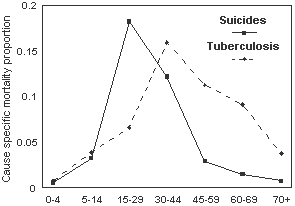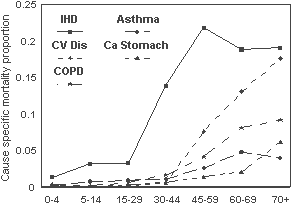Valid and reliable statistics on cause of death is an essential input for the setting of priorities in the health sector. Major initiatives to systematically identify health sector priorities have used cause of death information. An ideal cause of death reporting system consists of: (a) a fully developed vital registration system with, (b) cent percent medical attendance at the time of death, and (c) full compliance by the health care providers in the writing and filing of cause of death reports. Developing countries like India are making efforts to operate cause of death reporting systems that are feasible within the given constraints of partially developed registration of vital events and poor availability of medical facilities. We examine the cause of death reporting systems in India and usability of the statistics. For rural areas, cause of death statistics used to be collected through the SCD-Rural scheme which operated till December 1998.
There after, rural cause of death statistics is sought be generated by adding a few columns to capture cause of death information for deaths reported under the SRS-COD component. For urban areas, there is the medical certification of cause of death (MCCD) scheme extended by state governments, mostly to municipalities and urban areas. To assess the utility of cause of death statistics, we examine the SCD-Rural and MCCD data for a period of about five years in the first half of the 1990s using nine criteria for utility. These usability criteria are: (a) content validity of lay reporting systems, (b) adequate coverage and compliance, (c) validity of statistics at sub-national levels of disaggregation, (d) minimal usage of residual categories, such as unclassifiable or ill defined conditions, (e) consistency of cause- specific mortality proportions with general mortality level, (f) absence of incorrect assignment of causes with clear age-sex dependency, (g) no case of improbable age-sex distribution by cause, (h) consistency of cause-specific mortality proportion over time, and (i) timely compilation and publication of the statistics.

We find that major factors affecting the usability of the cause of death statistics in India are (a) poor coverage, (b) high incidence of unclassifiable deaths, (c) long delay and irregular publication of statistics, and (d) lack of systematic screening. We recommend, based on our subjective understanding of the problems, certain measures required to improve the utility of cause of death statistics in India. We propose that a drive be launched by the Ministry of Health, Government of India, and all State Governments through the Ministries of Health and Municipal Administration, to improve coverage by cause of death reporting systems. Based on our experience in Andhra Pradesh, we conjecture that introducing periodical reviews jointly by the Departments of Health and Municipal Administration, identification of non-reporting municipalities and sample units, and further identification of non reporting health care institutions sustained over a period of, say ,five years, will improve coverage substantially. Other measures recommended by us include: (a) training programmes to hone cause of death report writing skills among physicians, (b) compilation and publication of cause of death statistics at the State level, (c) sponsored research on cause of death structure and their policy implications, (d) computerisation of filing, tabulation and flow of cause of death statistics, both at the municipality and state level. To reduce the unusually high level of unclassifiable deaths, we recommend that an amendment be brought in the Registration of Births and Deaths Act (RBD Act.) making the maintenance of records mandatory in hospitals and health care institutions . We are unable to make any definite recommendations specifically for the rural areas, since system has been revamped recently. We wish to point out that the cause of death columns added to the SRS data collection forms do not provide for recording of symptoms necessary for the systematic screening and coding of cause of death reports. However, it is too early to sit in judgment on the new system. Research is recommended in order to evaluate the performance of the new cause of death reporting system in rural areas.
Leading causes of death - all age groups in Andhra Pradesh, 1991 |
|---|
| All |
Females |
Males |
| Cause |
% |
Cause |
% |
Cause |
% |
| Ischemic heart disease |
13.21 |
Ischemic heart disease |
12.2 |
Ischemic heart disease |
14.08 |
| Cerebrovascular disease |
8.11 |
Cerebrovascular disease |
8.33 |
Cerebrovascular disease |
7.92 |
| Lower respiratory infections |
7.02 |
Diarrhoeal diseases |
7.49 |
Tuberculosis |
7.76 |
| Diarrhoeal diseases |
6.61 |
Lower respiratory infections |
7.15 |
Lower respiratory infections |
6.91 |
| Tuberculosis |
6.32 |
Low birth weight |
5 |
Diarrhoeal diseases |
5.86 |
| Low birth weight |
4.96 |
Tuberculosis |
4.67 |
Chronic obstructive Pulmonary Disease |
5.34 |
| Chronic obstructive pulmonary disease |
4.76 |
Chronic obstructive Pulmonary Disease |
4.08 |
Low birth weight |
4.93 |
| Self-inflicted injury |
3.54 |
Self-inflicted injury |
3.76 |
Self-inflicted injury |
3.34 |
| Asthma |
2.55 |
Stomach cancer |
2.71 |
Asthma |
3.14 |
| Stomach cancer |
2.28 |
Dementia and other degenerative CNS dis |
2.09 |
Road accidents |
2.59 |
| |
|
|
|
Cirrhosis of the liver |
2.19 |
 Study to Estimate CoD:
Study to Estimate CoD:
To estimate the cause of death structure in rural areas, we implemented the Andhra Pradesh Rural Cause of Death (APRCD) study, 1998. All SCD-Rural death reports received by the state's Vital Statistics Division for a nine-month period, 1998 April to December, were systematically reviewed by a physician. SCD-Rural system uses verbal autopsy to determine cause of death in sample areas. Reports considered to have adequate information for assignment of cause of death from the non- medical list were coded by the physician. In some cases, this code was identical to code originally given by the SCD-Rural system and for some others there was a change in coding. Reports without adequate information for assignment of cause of death were dispatched for field enquiry and on-site review by a physician. A final cause of death code was assigned based on the on-site review. Additional deaths were detected by the visiting physicians from the same sample villages and pertaining to the study period. These deaths were investigated using verbal autopsy and a cause of death was assigned after systematic screening by another physician reviewer. Altogether 3842 deaths from the rural areas of Andhra Pradesh were investigated. For urban areas, MCCD data from the neighbouring state of Maharashtra for the years 1986-90 was used as an approximation. Deaths by cause in the rural and urban areas respectively were added up to arrive at the estimate of causes of death in Andhra Pradesh.



The above figure indicates the cause-specific mortality proportions for the same ten causes but within different age groups. Lower respiratory infection (LRI), diarrhoeal diseases and low birth weight predominantly affect infants and children. Poor nutrition, unsafe water, poor sanitation, and personal hygiene as well as access to appropriate treatment are responsible for the three main causes of death among children. In young adults, suicides and tuberculosis are the top causes of death. High incidence of suicides is a pointer to educational, social and cultural factors. Tuberculosis continues to be an important public health problem despite decade-long programmes to control the incidence of this disease. Ischaemic heart disease shows up as an important cause of death among older adults and further increases as age advances. Other important causes of death for older adults are cerebrovascular disease, chronic obstructive pulmonary diseases, asthma and Stomach cancer. Ischaemic heart diseases, and cerebrovascular diseases call for changes in lifestyle. Chronic obstructive pulmonary diseases point to the need for control of indoor and outdoor air pollution and smoking. Stomach cancer could be, to some extent, dealt with by early diagnosis and treatment. In a nutshell, the mortality profile of Andhra Pradesh clearly reflects the persisting problems arising from poor nutrition, water supply and hygiene as also socio- cultural problems and the emergence of non communicable and degenerative diseases.
